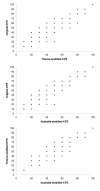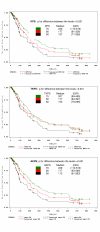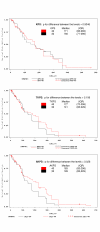The Australia-modified Karnofsky Performance Status (AKPS) scale: a revised scale for contemporary palliative care clinical practice [ISRCTN81117481]
- PMID: 16283937
- PMCID: PMC1308820
- DOI: 10.1186/1472-684X-4-7
The Australia-modified Karnofsky Performance Status (AKPS) scale: a revised scale for contemporary palliative care clinical practice [ISRCTN81117481]
Abstract
Background: The Karnofsky Performance Status (KPS) is a gold standard scale. The Thorne-modified KPS (TKPS) focuses on community-based care and has been shown to be more relevant to palliative care settings than the original KPS. The Australia-modified KPS (AKPS) blends KPS and TKPS to accommodate any setting of care.
Methods: Performance status was measured using all three scales for palliative care patients enrolled in a randomized controlled trial in South Australia. Care occurred in a range of settings. Survival was defined from enrollment to death.
Results: Ratings were collected at 1600 timepoints for 306 participants. The median score on all scales was 60. KPS and AKPS agreed in 87% of ratings; 79% of disagreements occurred within 1 level on the 11-level scales. KPS and TKPS agreed in 76% of ratings; 85% of disagreements occurred within one level. AKPS and TKPS agreed in 85% of ratings; 87% of disagreements were within one level. Strongest agreement occurred at the highest levels (70-90), with greatest disagreement at lower levels (< or =40). Kappa coefficients for agreement were KPS-TKPS 0.71, KPS-AKPS 0.84, and AKPS-TKPS 0.82 (all p < 0.001). Spearman correlations with survival were KPS 0.26, TKPS 0.27 and AKPS 0.26 (all p < 0.001). AKPS was most predictive of survival at the lower range of the scale. All had longitudinal test-retest validity. Face validity was greatest for the AKPS.
Conclusion: The AKPS is a useful modification of the KPS that is more appropriate for clinical settings that include multiple venues of care such as palliative care.
Figures






Similar articles
-
Performance status assessment in home hospice patients using a modified form of the Karnofsky Performance Status Scale.J Palliat Med. 2000 Fall;3(3):301-11. doi: 10.1089/jpm.2000.3.301. J Palliat Med. 2000. PMID: 15859671
-
Clinical frailty and performance scale translation in palliative care: scoping review.BMJ Support Palliat Care. 2022 Jun 1:bmjspcare-2022-003658. doi: 10.1136/bmjspcare-2022-003658. Online ahead of print. BMJ Support Palliat Care. 2022. PMID: 35649714 Review.
-
Delivery strategies to optimize resource utilization and performance status for patients with advanced life-limiting illness: results from the "palliative care trial" [ISRCTN 81117481].J Pain Symptom Manage. 2013 Mar;45(3):488-505. doi: 10.1016/j.jpainsymman.2012.02.024. Epub 2012 Oct 24. J Pain Symptom Manage. 2013. PMID: 23102711 Clinical Trial.
-
Validating performance status and activities of daily living assessment tools for Chinese palliative care in a cancer setting: A cross-cultural psychometric study.Asia Pac J Oncol Nurs. 2024 Oct 29;11(12):100613. doi: 10.1016/j.apjon.2024.100613. eCollection 2024 Dec. Asia Pac J Oncol Nurs. 2024. PMID: 39641010 Free PMC article.
-
[Standards, options and recommendations: nutritional support in palliative or terminal care of adult patients with progressive cancer].Bull Cancer. 2001 Oct;88(10):985-1006. Bull Cancer. 2001. PMID: 11713035 Review. French.
Cited by
-
Relationship between timeliness of contact and length of stay in older and younger patients of a consultation-liaison psychiatry service.BJPsych Bull. 2015 Jun;39(3):128-33. doi: 10.1192/pb.bp.114.047340. BJPsych Bull. 2015. PMID: 26191451 Free PMC article.
-
Survival Prediction in Home Hospice Care Patients with Lung Cancer Based on LASSO Algorithm.Cancer Control. 2022 Jan-Dec;29:10732748221124519. doi: 10.1177/10732748221124519. Cancer Control. 2022. PMID: 36039467 Free PMC article.
-
Preferences and priorities to manage clinical uncertainty for older people with frailty and multimorbidity: a discrete choice experiment and stakeholder consultations.BMC Geriatr. 2021 Oct 14;21(1):553. doi: 10.1186/s12877-021-02480-8. BMC Geriatr. 2021. PMID: 34649510 Free PMC article.
-
Multicomponent non-pharmacological intervention to prevent delirium for hospitalised people with advanced cancer: study protocol for a phase II cluster randomised controlled trial.BMJ Open. 2019 Jan 28;9(1):e026177. doi: 10.1136/bmjopen-2018-026177. BMJ Open. 2019. PMID: 30696686 Free PMC article.
-
Indigenous compared with non-Indigenous Australian patients at entry to specialist palliative care: Cross-sectional findings from a multi-jurisdictional dataset.PLoS One. 2019 May 2;14(5):e0215403. doi: 10.1371/journal.pone.0215403. eCollection 2019. PLoS One. 2019. PMID: 31048843 Free PMC article.
References
-
- Abernethy AP, Currow DC, Hunt R, Williams H, Roder-Allen G, Rowett D, Shelby-James T, Esterman A, May F, Phillips PA. A pragmatic 2x2x2 factorial cluster randomized controlled trial of educaitonal outreach visiting and case conferencing in palliative care. Methodology of the Palliative Care Trial. Contemp Clin Trials. 2005 - PubMed
-
- Kaasa T, Wessel J. The Edmonton Functional Assessment Tool: further development and validation for use in palliative care. Journal of Palliative Care. 2001;17:5–11. - PubMed
-
- Karnofsky D, Abelmann W, Craver L, Burchenal J. The use of nitrogen mustard in the palliative treatment of cancer. Cancer. 1948;1:634–656.
LinkOut - more resources
Full Text Sources
Medical

